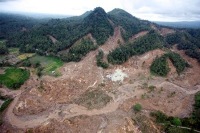Special Program for International Students
GRADUATE COURSE IN EARTH SCIENCE
& GEOENVIRONMENTAL SCIENCE
Current MEXT students
Fikri Faris (Indonesia)
Email: s119707 @matsu.shimane-u.ac.jp
Thesis title: Initiation mechanism of earthquake-rainfall triggered landslides by considering soil dynamic properties and groundwater condition.
Supervisor: Prof. Fawu Wang (2011-1014)
Indonesia is an archipelago of tropical islands that form part of one of the world’s most active volcanic chains. Most of its regions are seismically active and consist of many volcanic mountains, hilly areas, and complex geological features which have the potential to cause landslides. Rainfall and earthquakes are natural phenomena that are usually considered to be the main triggering factors for landslides.
My previous study of landslides comprised landslide mass movement simulation based on real-time monitoring of displacement, rainfall and groundwater fluctuation that is established in the Banjarnegara District, of Central Java. The results of the study indicated that there is a very strong correlation between rainfall and landslide mass displacement.
My next research will focus on two natural triggers for landslides: rainfall and earthquakes. The landslide potential due to this combination of trigger can be catastrophic, affecting wide areas, and inducing secondary disasters. Some areas in Indonesia have potential for earthquake-triggered landslides which poses threats for large regions in the country. The 2009 M 7.6 earthquake in West Sumatra Province generated many flowslides in the mountainous areas of Tandikek and Malalak. These slides destroyed villages and took many lives. Work by Wang et al. (2010) found these flowslides occurred on pumice-mantled mountain slopes during heavy rainfall. The combination of intensive rainfall and strong earthquake decreases slope stability dramatically. This research showed the necessity of considering effects of the unfortunate combination of independent events such as rainfall and earthquake.
The objectives of my research are to:
- Perform site investigation to gain more information about the geological features in specific areas, including presence and activity of surrounding active faults, rock/soil type and stratigraphy, geo-morphology, and the potential slip surface.
- Conduct laboratory tests to examine the mechanisms of earthquake-triggered landslides, i.e. using cyclic tri-axial apparatus.
- Perform geotechnical landslide simulation modeling using appropriate computer code that may ultimately determine the probability of landslides during combined earthquake-rainfall events in specific areas.


